Research on User Behavior Based on Higher-Order Dependency Network
Abstract
1. Introduction
- We use the BuildHON+ algorithm to extract the higher-order dependency rules and build the HON of user behaviors.
- On this basis, we use RandomWalk, PageRank, and MapEquation algorithms to analyze the HON of user behavior, and compare the results in the FON, which shows the advantages of the HON over the FON.
2. Related Works
3. Markov Process Considering Order
3.1. First-Order Markov Process
3.2. Higher-Order Markov Process
4. Higher-Order Dependency Network
4.1. Concept and Introduction
4.2. Construction of HON
4.2.1. Rule Extraction
- According to the given sequence, calculate the frequency of all subsequences more than the minimum support (MinSupport) from the second order to the highest order (MaxOrder).
- Starting from the second order, calculate the distribution frequency of the higher-order subsequence and the current subsequence.
- Compare whether the frequency distribution of the two sequences changes significantly, and accept the higher-order subsequence as a rule if there is a significant change; otherwise, use the current order subsequence as a rule.
4.2.2. Network Rewiring
- Convert all first-order rules to edges;
- Convert higher-order rules into edges and create corresponding higher-order nodes;
- Add incoming edges for higher-order nodes;
- The target nodes in the higher-order rules are all first-order, but if there are corresponding higher-order nodes generated by other rules at this time, the first-order target nodes can be merged into the higher-order nodes.
5. Experiments
5.1. Datasets and Design of Experiments
5.2. Data Preprocessing
5.2.1. Converting Videos to Sequence Data
5.2.2. Dividing Data by Scene
5.2.3. Network Construction
5.3. Performance of Random Walk on FON and HON
5.3.1. Introduction of Experiment
5.3.2. Results without Division of Scenes
5.3.3. Results with Division of Scenes
5.3.4. Analysis of Results
5.4. Performance of PageRank on FON and HON
5.4.1. Introduction of Experiment
5.4.2. Results of Experiment
5.4.3. Analysis of Results
5.4.4. Comparison of Different Vital Node Identification Algorithms
5.5. Performance of Infomap on FON and HON
5.5.1. Introduction of Experiment
5.5.2. Results without Division of Scenes
5.5.3. Results with Division of Scenes
5.5.4. Analysis of Results
5.5.5. Comparison of Different Community Detection Algorithms
5.6. Summary and Analysis of Experimental Results
- Higher-order dependencies cause the network to have more accurate state transitions, and all network algorithms based on state transition will benefit.
- Higher-order dependencies can change the importance of nodes in the network, which can eliminate some errors caused by inappropriate first-order connections.
- Higher-order dependency changes the membership of nodes to communities, which is different from the single membership of nodes and communities in the FON. After considering higher-order dependency, nodes have multiple membership.
6. Summary and Discussion
Author Contributions
Funding
Institutional Review Board Statement
Data Availability Statement
Acknowledgments
Conflicts of Interest
References
- Luo, X.; Wang, J.; Shen, Q.; Wang, J. User Behavior Analysis Based on User Interest by Web Log Mining. In Proceedings of the 2017 27th International Telecommunication Networks And Applications Conference (ITNAC), Melbourne, VIC, Australia, 22–24 November 2017; pp. 486–490. [Google Scholar]
- Qinglong, L.; Cui, S.; Shin, B.; JaeKyeong, K. A Study of Deep Learning-based Personalized Recommendation Service for Solving Online Hotel Review and Rating Mismatch Problem. Inf. Syst. Rev. 2021, 23, 51–75. [Google Scholar]
- Liao, S.H.; Chen, Y.N.; Tseng, Y.Y. Mining demand chain knowledge of life insurance market for new product development. Expert Syst. Appl. 2009, 36, 9422–9437. [Google Scholar] [CrossRef]
- Gaku, R. Demand forecasting procedure for short life-cycle products with an actual food processing enterprise. Int. J. Comput. Intell. Syst. 2014, 7, 85–92. [Google Scholar] [CrossRef]
- Park, S.; Han, S.; Son, Y. Demand power forecasting with data mining method in smart grid. In Proceedings of the 2017 IEEE Innovative Smart Grid Technologies—Asia: Smart Grid for Smart Community, ISGT-Asia 2017, Auckland, New Zealand, 4–7 December 2018; pp. 1–6. [Google Scholar] [CrossRef]
- Yang, A.; Zhang, W.; Wang, J.; Yang, K.; Han, Y.; Zhang, L. Review on the Application of Machine Learning Algorithms in the Sequence Data Mining of DNA. Front. Bioeng. Biotechnol. 2020, 8, 1032. [Google Scholar] [CrossRef] [PubMed]
- Qu, J.; Wu, S.; Zhang, J. Flight Delay Propagation Prediction Based on Deep Learning. Mathematics 2023, 11, 494. [Google Scholar] [CrossRef]
- Xiang, X.; Zhou, J. An Excess Entropy Approach to Classify Long-Term and Short-Term Memory Stationary Time Series. Mathematics 2023, 11, 2448. [Google Scholar] [CrossRef]
- Zhang, Z.L.; Liu, Z.C.; Tian, M.F. Network Behavior Analysis Based on Association Rules. In Proceedings of the International Conference on Automation, Mechanical and Electrical Engineering (AMEE 2015), Phuket, Thailand, 26–27 July 2015; pp. 1066–1072. [Google Scholar]
- Xu, J.; Wickramarathne, T.L.; Chawla, N.V. Representing higher-order dependencies in networks. Sci. Adv. 2016, 2, e1600028. [Google Scholar] [CrossRef]
- Aguirre-Guerrero, D.; Bernal-Jaquez, R. A Methodology for the Analysis of Collaboration Networks with Higher-Order Interactions. Mathematics 2023, 11, 2265. [Google Scholar] [CrossRef]
- Li, X.; Zhao, C.; Hu, Z.; Yu, C.; Duan, X. Revealing the character of journals in higher-order citation networks. Scientometrics 2022, 127, 6315–6338. [Google Scholar] [CrossRef]
- Lambiotte, R.; Rosvall, M.; Scholtes, I. From networks to optimal higher-order models of complex systems. Nat. Phys. 2019, 15, 313–320. [Google Scholar] [CrossRef]
- Saebi, M.; Xu, J.; Kaplan, L.M.; Ribeiro, B.; Chawla, N.V. Efficient modeling of higher-order dependencies in networks: From algorithm to application for anomaly detection. EPJ Data Sci. 2020, 9, 15. [Google Scholar] [CrossRef]
- Sigurdsson, G.A.; Varol, G.; Wang, X.; Farhadi, A.; Laptev, I.; Gupta, A. Hollywood in homes: Crowdsourcing data collection for activity understanding. In Proceedings of the Lecture Notes in Computer Science (Including Subseries Lecture Notes in Artificial Intelligence and Lecture Notes in Bioinformatics), Amsterdam, The Netherlands, 11–14 October 2016; Volume 9905, pp. 510–526. [Google Scholar] [CrossRef]
- Sigurdsson, G.A.; Gupta, A.; Schmid, C.; Farhadi, A.; Alahari, K. Actor and Observer: Joint Modeling of First and Third-Person Videos. In Proceedings of the IEEE Computer Society Conference on Computer Vision and Pattern Recognition, Salt Lake City, UT, USA, 18–22 June 2018; pp. 7396–7404. [Google Scholar] [CrossRef]
- Sweis, B.M.; Nestler, E.J. Pushing the boundaries of behavioral analysis could aid psychiatric drug discovery. PLoS Biol. 2022, 20, e3001904. [Google Scholar] [CrossRef] [PubMed]
- Finn, E.S.; Bandettini, P.A. Movie-watching outperforms rest for functional connectivity-based prediction of behavior. NeuroImage 2021, 235, 117963. [Google Scholar] [CrossRef] [PubMed]
- Chen, H.; Zhang, A.; Hu, S. Behavior prediction for Ochotona curzoniae based on wavelet neural network. In Proceedings of the Lecture Notes in Computer Science (Including Subseries Lecture Notes in Artificial Intelligence and Lecture Notes in Bioinformatics), Lanzhou, China, 2–5 August 2016; Volume 9772, pp. 105–116. [Google Scholar] [CrossRef]
- Vargis, T.R.; Ghiasvand, S. Assessing Anonymized System Logs Usefulness for Behavioral Analysis in RNN Models. arXiv 2022, arXiv:2212.01101. [Google Scholar]
- Park, J.; Jang, R.; Mohaisen, M.; Mohaisen, D. A Large-Scale Behavioral Analysis of the Open DNS Resolvers on the Internet. IEEE ACM Trans. Netw. 2022, 30, 76–89. [Google Scholar] [CrossRef]
- Malik, M.; Nandal, R.; Dalal, S.; Maan, U.; Le, D.N. An efficient driver behavioral pattern analysis based on fuzzy logical feature selection and classification in big data analysis. J. Intell. Fuzzy Syst. 2022, 43, 3283–3292. [Google Scholar] [CrossRef]
- Choi, S.; Kim, C.; Kang, Y.S.; Youm, S. Human behavioral pattern analysis-based anomaly detection system in residential space. J. Supercomput. 2021, 77, 9248–9265. [Google Scholar] [CrossRef]
- Brandizzi, N.; Russo, S.; Galati, G.; Napoli, C. Addressing Vehicle Sharing through Behavioral Analysis: A Solution to User Clustering Using Recency-Frequency-Monetary and Vehicle Relocation Based on Neighborhood Splits. Information 2022, 13, 511. [Google Scholar] [CrossRef]
- Tiwari, A.; Dhiman, V.; Iesa, M.A.; Alsarhan, H.; Mehbodniya, A.; Shabaz, M. Patient Behavioral Analysis with Smart Healthcare and IoT. Behav. Neurol. 2021, 2021, 4028761. [Google Scholar] [CrossRef]
- Torres, L.; Blevins, A.S.; Bassett, D.; Eliassi-Rad, T. The why, how, and when of representations for complex systems. SIAM Rev. 2021, 63, 435–485. [Google Scholar] [CrossRef]
- Gebhart, T.; Funk, R.J. The Emergence of Higher-Order Structure in Scientific and Technological Knowledge Networks. arXiv 2020, arXiv:2009.13620. [Google Scholar] [CrossRef]
- Chavan, N.; Potika, K. Higher-order Link Prediction Using Triangle Embeddings. In Proceedings of the 2020 IEEE International Conference on Big Data, Big Data 2020, Atlanta, GA, USA, 10–13 December 2020; pp. 4535–4544. [Google Scholar] [CrossRef]
- Battiston, F.; Cencetti, G.; Iacopini, I.; Latora, V.; Lucas, M.; Patania, A.; Young, J.G.; Petri, G. Networks beyond pairwise interactions: Structure and dynamics. Phys. Rep. 2020, 874, 1–92. [Google Scholar] [CrossRef]
- Young, J.G.; Petri, G.; Peixoto, T.P. Hypergraph reconstruction from network data. Commun. Phys. 2021, 4, 135. [Google Scholar] [CrossRef]
- Iacopini, I.; Petri, G.; Barrat, A.; Latora, V. Simplicial models of social contagion. Nat. Commun. 2019, 10, 2485. [Google Scholar] [CrossRef]
- Vasilyeva, E.; Romance, M.; Samoylenko, I.; Kovalenko, K.; Musatov, D.; Raigorodskii, A.M.; Boccaletti, S. Distances in Higher-Order Networks and the Metric Structure of Hypergraphs. Entropy 2023, 25, 923. [Google Scholar] [CrossRef]
- Zhang, C.; Lei, Y.; Shen, X.; Li, Q.; Yao, H.; Cheng, D.; Xie, Y.; Yu, W. Fragility Induced by Interdependency of Complex Networks and Their Higher-Order Networks. Entropy 2023, 25, 22. [Google Scholar] [CrossRef] [PubMed]
- Rosvall, M.; Esquivel, A.V.; Lancichinetti, A.; West, J.D.; Lambiotte, R. Memory in network flows and its effects on spreading dynamics and community detection. Nat. Commun. 2014, 5, 4630. [Google Scholar] [CrossRef] [PubMed]
- Saebi, M.; Ciampaglia, G.L.; Kaplan, L.M.; Chawla, N.V. HONEM: Learning Embedding for Higher Order Networks. Big Data 2020, 8, 255–269. [Google Scholar] [CrossRef] [PubMed]
- Krieg, S.J.; Kogge, P.M.; Chawla, N.V. GrowHON: A scalable algorithm for growing Higher-order networks of sequences. In Complex Networks & Their Applications IX: Volume 2, Proceedings of the Ninth International Conference on Complex Networks and Their Applications Complex Networks 2020, Madrid, Spain, 1–3 December 2020; Springer: Cham, Switzerland, 2021; pp. 485–496. [Google Scholar]
- Saebi, M.; Xu, J.; Curasi, S.R.; Grey, E.K.; Chawla, N.V.; Lodge, D.M. Network analysis of ballast-mediated species transfer reveals important introduction and dispersal patterns in the Arctic. Sci. Rep. 2020, 10, 19558. [Google Scholar] [CrossRef] [PubMed]
- Page, L.; Brin, S. The PageRank Citation Ranking: Bringing Order to the Web. Stanf. Digit. Libr. Work. Pap. 1998, 98, 161–172. [Google Scholar] [CrossRef]
- Lü, L.; Zhang, Y.C.; Yeung, C.H.; Zhou, T. Leaders in social networks, the delicious case. PLoS ONE 2011, 6, e21202. [Google Scholar] [CrossRef] [PubMed]
- Kleinberg, J.M. Authoritative sources in a hyperlinked environment. J. ACM 1999, 46, 604–632. [Google Scholar] [CrossRef]
- Solá, L.; Romance, M.; Criado, R.; Flores, J.; García del Amo, A.; Boccaletti, S. Eigenvector centrality of nodes in multiplex networks. Chaos 2013, 23, 33131. [Google Scholar] [CrossRef] [PubMed]
- Leicht, E.A.; Newman, M.E. Community structure in directed networks. Phys. Rev. Lett. 2008, 100, 118703. [Google Scholar] [CrossRef]
- Rosvall, M.; Axelsson, D.; Bergstrom, C.T. The map equation. Eur. Phys. J. Spec. Top. 2009, 178, 13–23. [Google Scholar] [CrossRef]
- Blondel, V.D.; Guillaume, J.L.; Lambiotte, R.; Lefebvre, E. Fast unfolding of communities in large networks. J. Stat. Mech. Theory Exp. 2008, 2008, 10008. [Google Scholar] [CrossRef]
- Newman, M.E. Fast algorithm for detecting community structure in networks. Phys. Rev. E Stat. Phys. Plasmas Fluids Relat. Interdiscip. Top. 2004, 69, 5. [Google Scholar] [CrossRef]
- Newman, M.E. Modularity and community structure in networks. Proc. Natl. Acad. Sci. USA 2006, 103, 8577–8582. [Google Scholar] [CrossRef]
- Perozzi, B.; Al-Rfou, R.; Skiena, S. DeepWalk: Online learning of social representations. In Proceedings of the ACM SIGKDD International Conference on Knowledge Discovery and Data Mining, New York, NY, USA, 24–27 August 2014; pp. 701–710. [Google Scholar] [CrossRef]
- Grover, A.; Leskovec, J. Node2vec: Scalable feature learning for networks. In Proceedings of the ACM SIGKDD International Conference on Knowledge Discovery and Data Mining, San Francisco, CA, USA, 13–17 August 2016; pp. 855–864. [Google Scholar] [CrossRef]

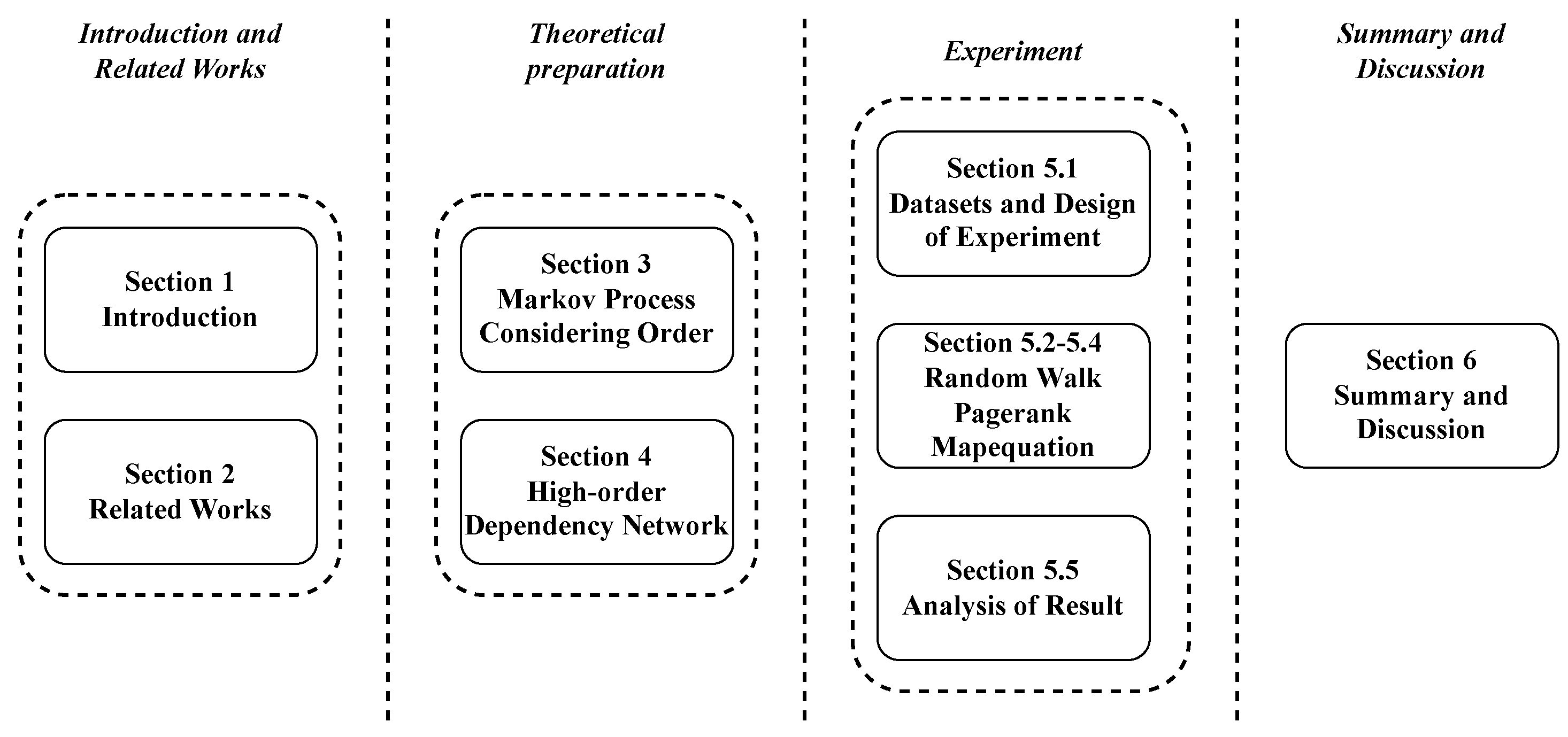
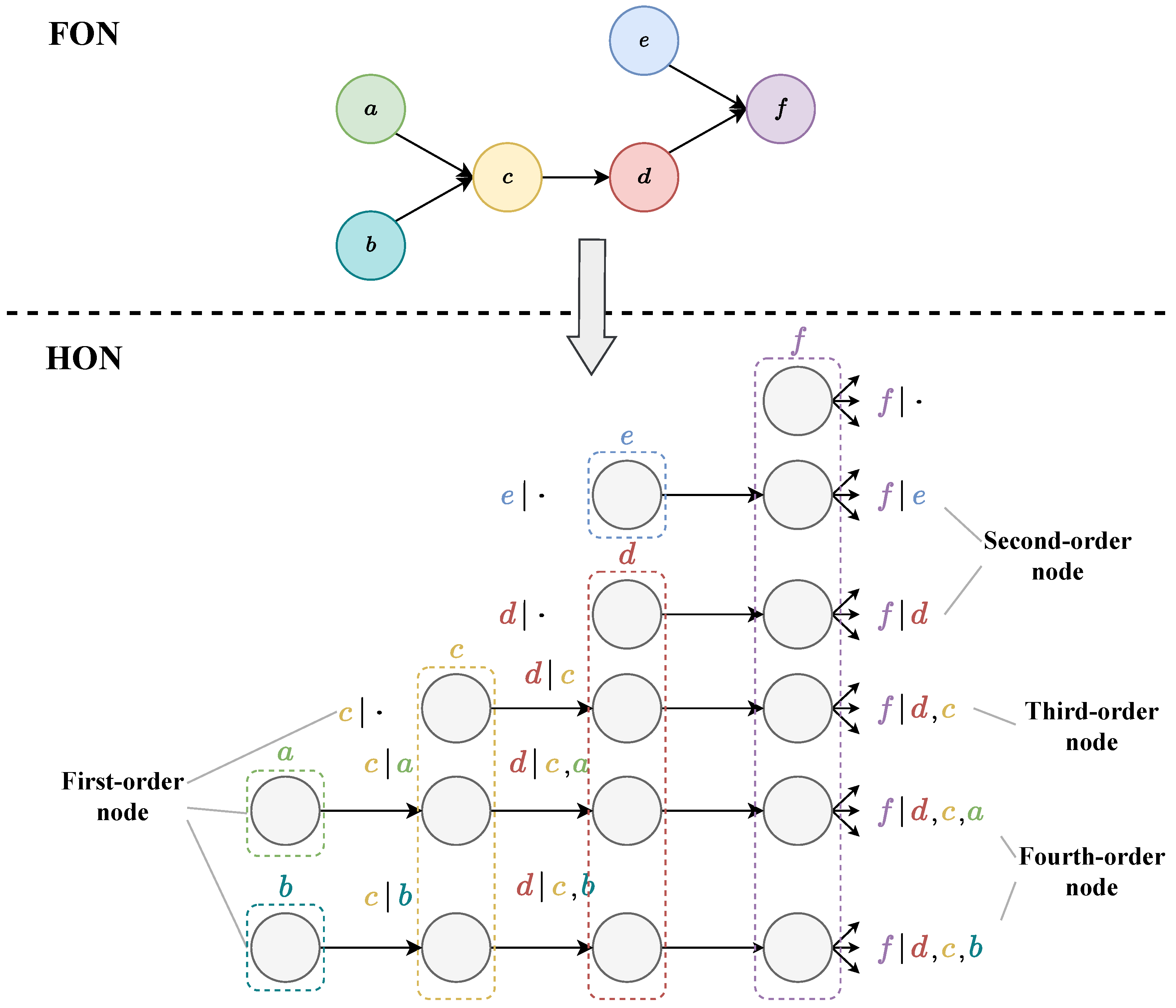
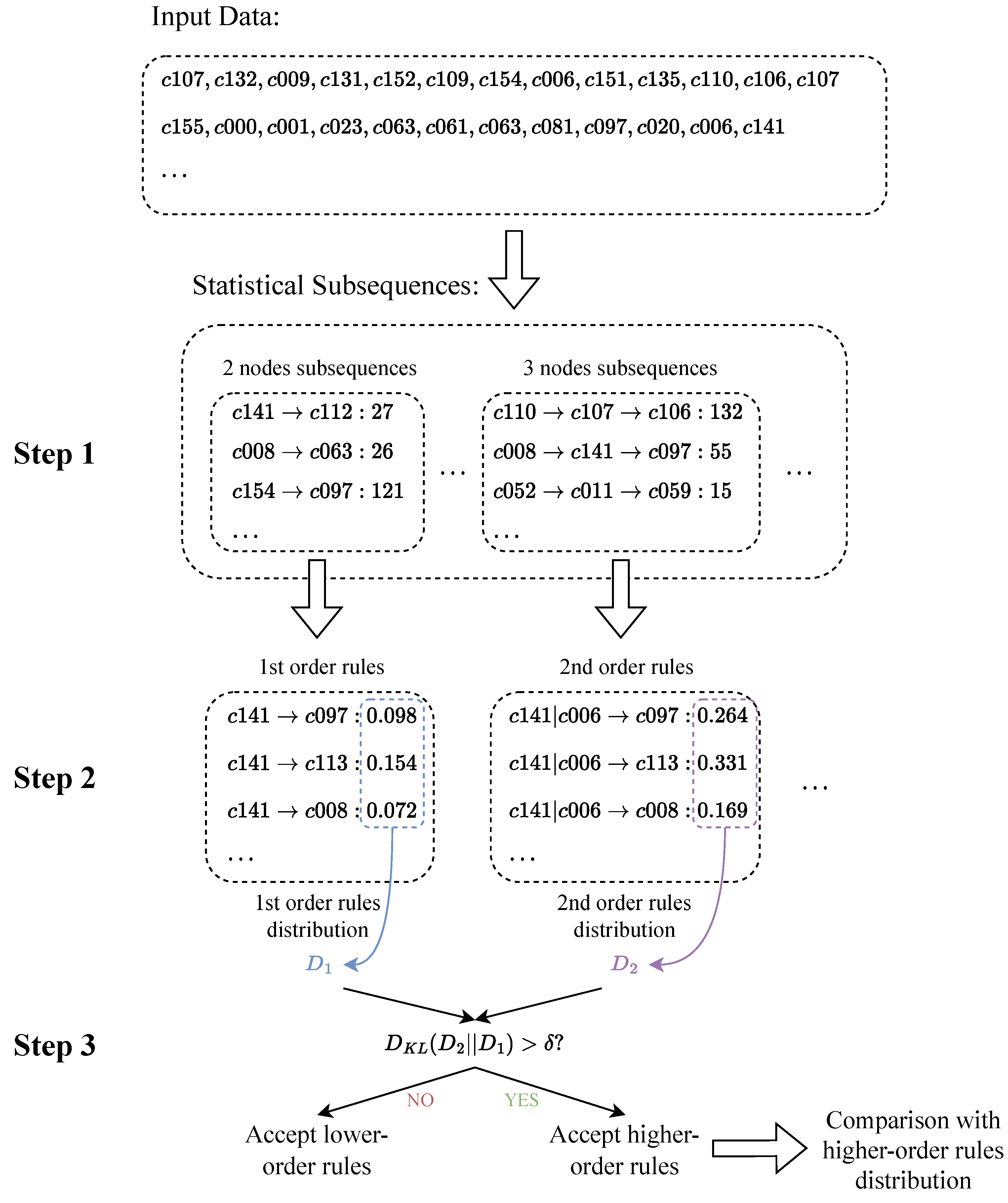
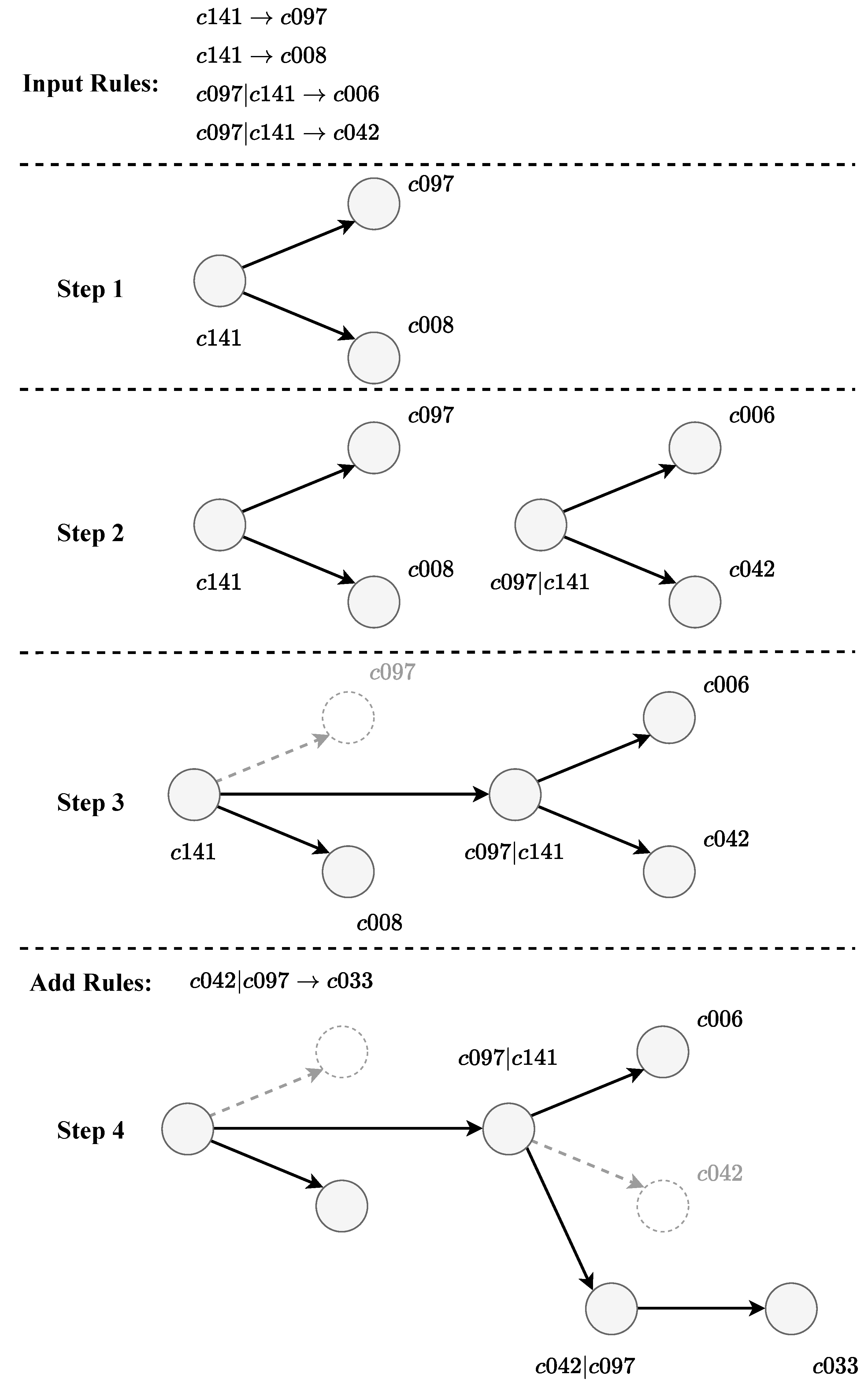


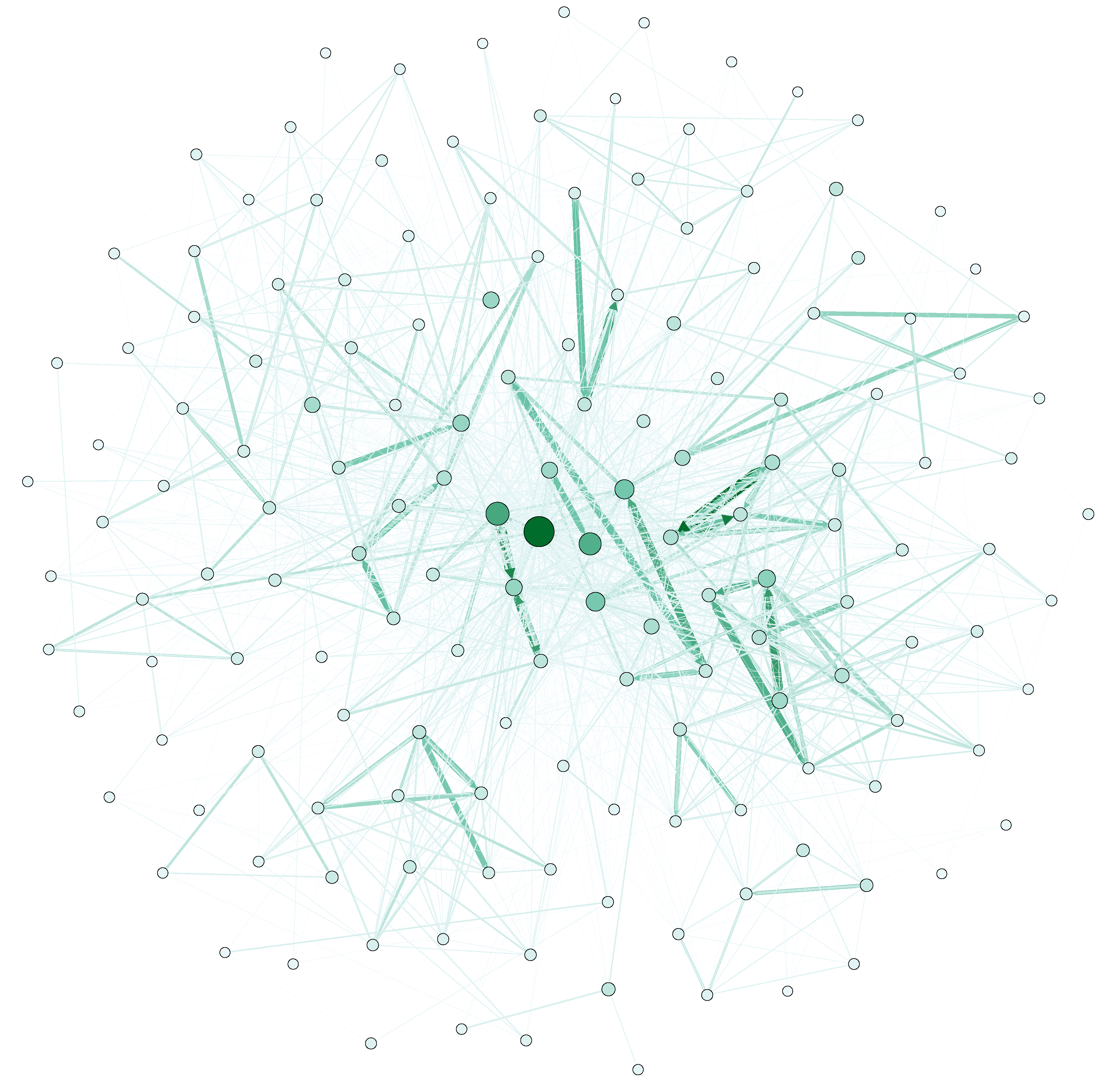
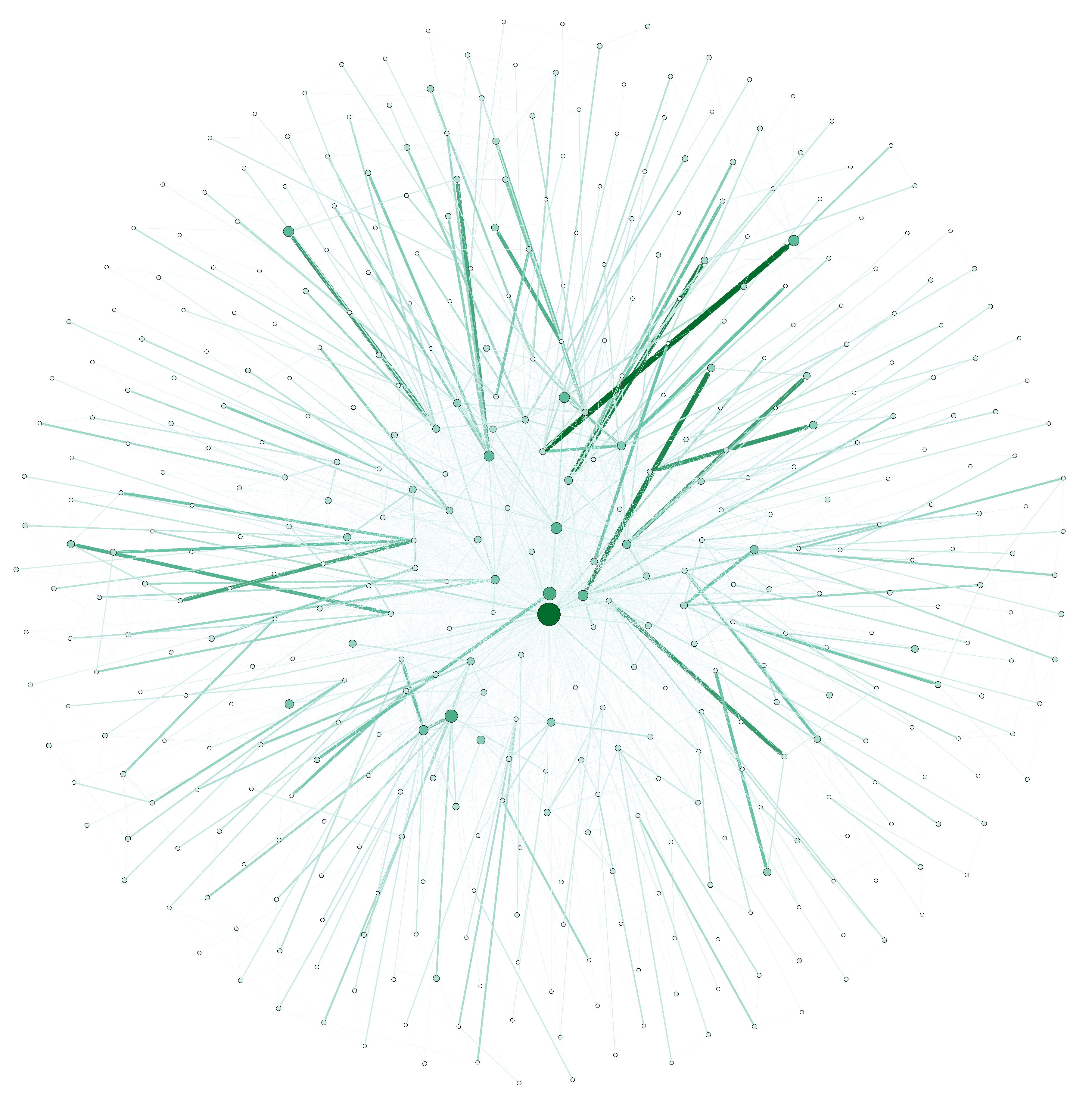
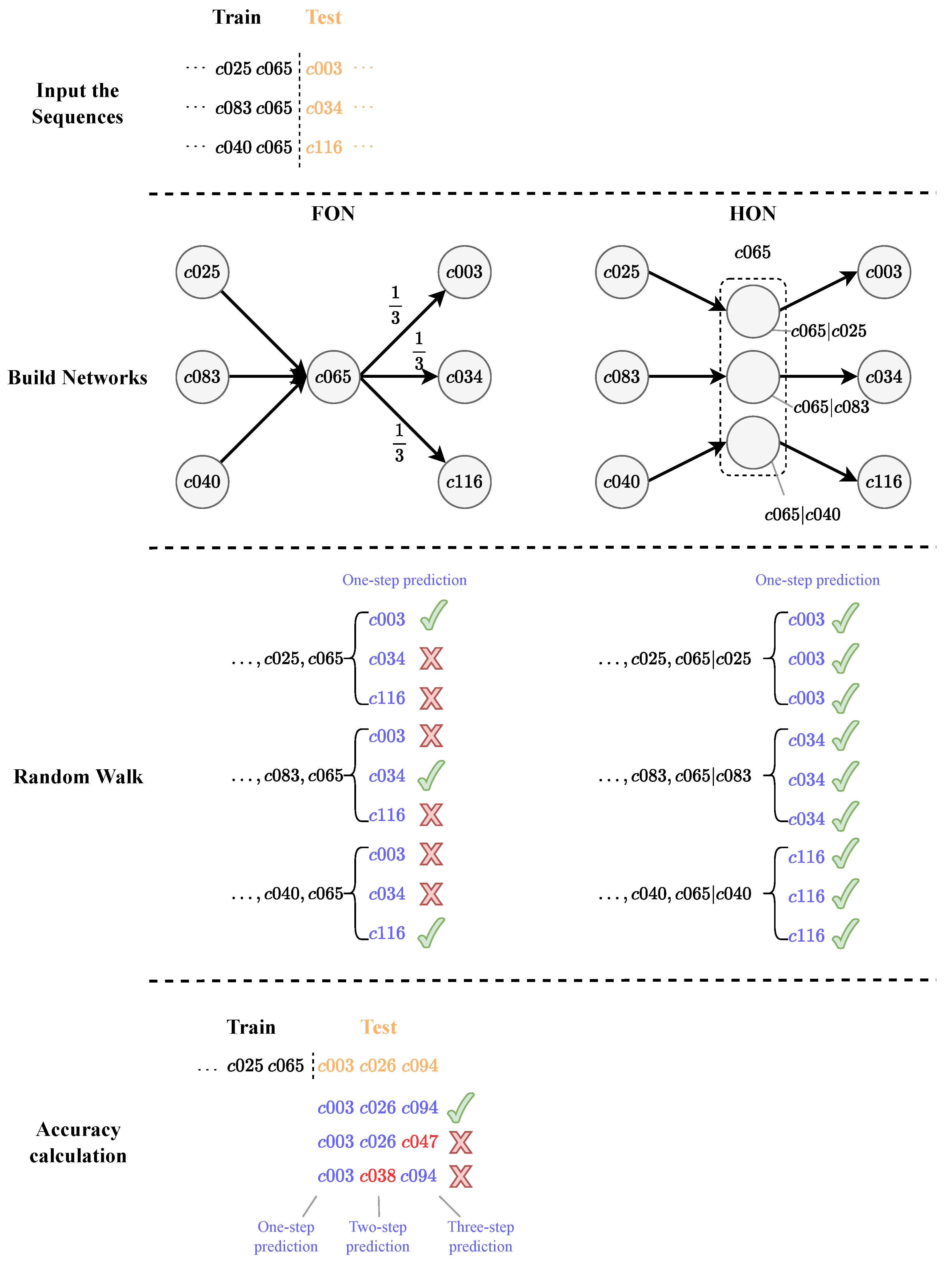



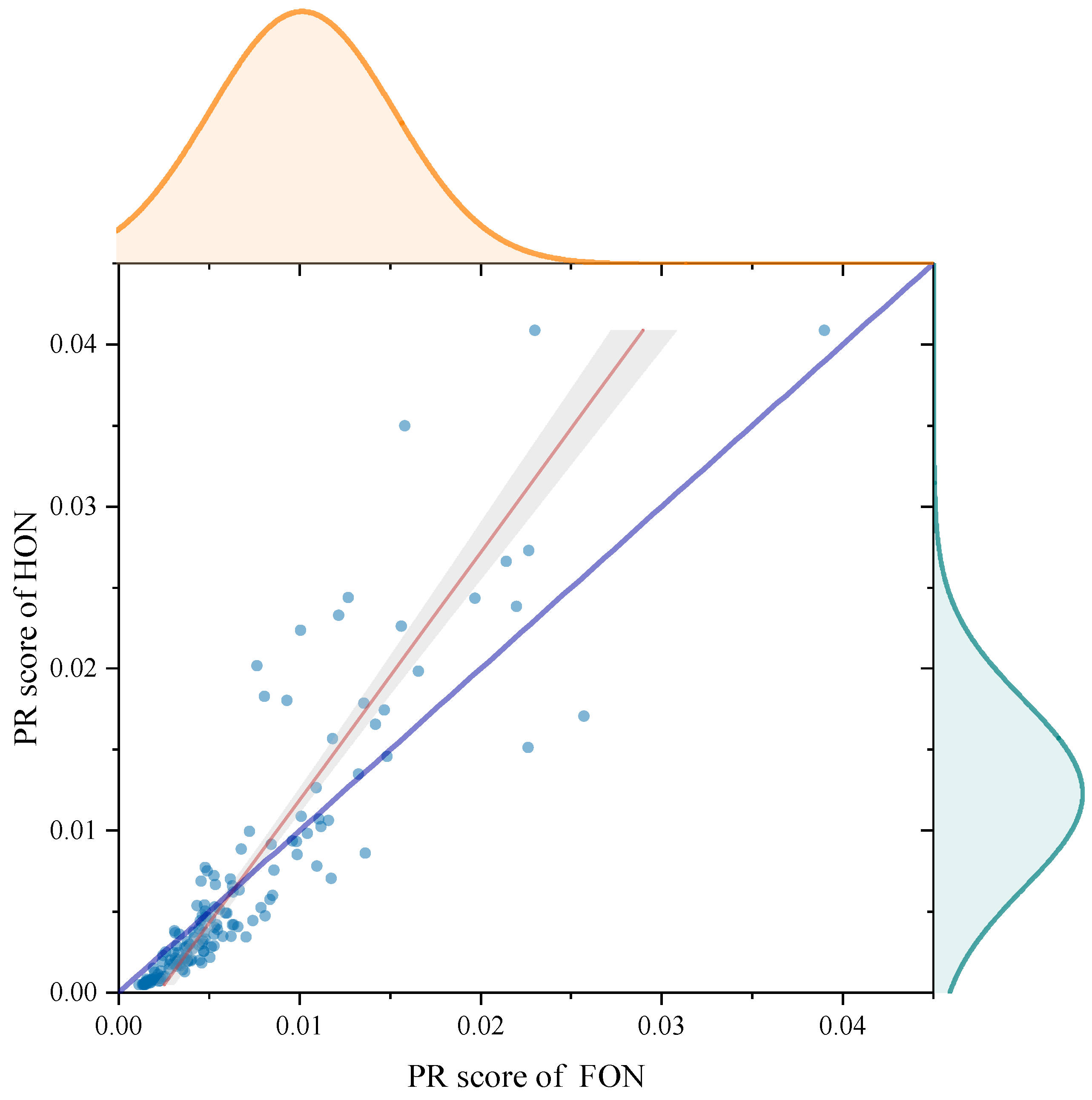
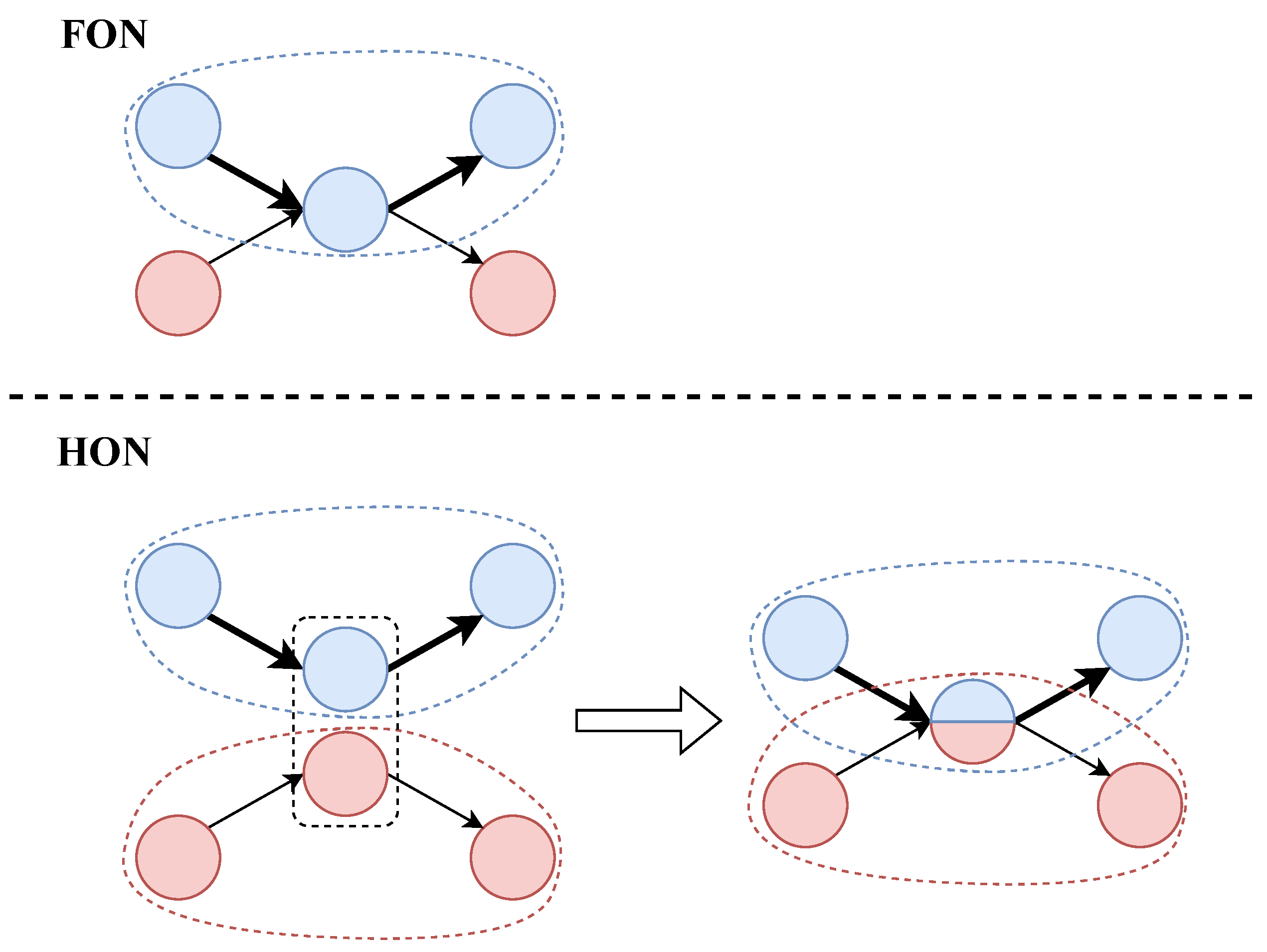
| Markov Process Order | |||
|---|---|---|---|
| First-Order | Higher-Order | ||
| Transfer steps | One-step | Node to node | Path to node |
| Multistep | Node to path | Path to path | |
| Scene | Size of Dataset | Average Length of Sequence |
|---|---|---|
| Basement | 250 | 7.27 |
| Home office | 964 | 8.65 |
| Bathroom | 1144 | 7.15 |
| Kitchen | 3078 | 8.86 |
| Bedroom | 3213 | 9.08 |
| Laundry room | 727 | 8.23 |
| Closet | 680 | 8.61 |
| Living room | 2815 | 9.12 |
| Dining room | 925 | 9.12 |
| Pantry | 449 | 8.54 |
| Entryway | 882 | 8.48 |
| Recreation room | 462 | 8.60 |
| Garage | 378 | 7.14 |
| Stairs | 755 | 7.65 |
| Hallway | 775 | 8.14 |
| Other | 211 | 8.26 |
| Attributes | FON | HON |
|---|---|---|
| Number of nodes | 157 | 438 |
| Number of edges | 2642 | 3107 |
| Average degree | 16.828 | 7.094 |
| Average weighted degree | 497.548 | 196.153 |
| Density | 0.108 | 0.016 |
| Node Name | Change of Score | Node Name | Change of Score |
|---|---|---|---|
| c156 | c151 | ||
| c061 | c152 | ||
| c065 | c033 |
| Rank | PageRank | LeaderRank | Hits | Eigenvector Centrality | ||||
|---|---|---|---|---|---|---|---|---|
| FON | HON | FON | HON | FON | HON | FON | HON | |
| 1 | c154 | c154 | c154 | c154 | c107 | c059 | c154 | c154 |
| 2 | c151 | c061 | c097 | c059 | c061 | c154 | c151 | c151 |
| 3 | c061 | c156 | c151 | c151 | c059 | c107 | c152 | c152 |
| 4 | c152 | c009 | c059 | c097 | c106 | c106 | c009 | c009 |
| 5 | c009 | c059 | c152 | c152 | c154 | c151 | c097 | c061 |
| Number of Community | Community Size | Community Assignment | Size of Largest Community | |
|---|---|---|---|---|
| FON | 17 | 9.24 | 1 | 27 |
| HON | 26 | 16.85 | 1.39 | 40 |
| Bathroom | Bedroom | Kitchen | Living Room | |||||
|---|---|---|---|---|---|---|---|---|
| FON | HON | FON | HON | FON | HON | FON | HON | |
| Number of community | 19 | 23 | 15 | 58 | 9 | 64 | 2 | 70 |
| Community size | 7.11 | 9.43 | 10.4 | 13.28 | 17.44 | 18.05 | 78.5 | 20.07 |
| Community assignment | 1 | 1.26 | 1 | 3.71 | 1 | 5.05 | 1 | 5.73 |
| Size of largest community | 19 | 24 | 42 | 53 | 68 | 77 | 148 | 103 |
| Number of higher -order rules | - | 88 | - | 764 | - | 650 | - | 624 |
| Percentage of higher -order rules | - | 13.04% | - | 25.38% | - | 23.78% | - | 24.22% |
| Infomap | Louvian | Greedy Modularity | ||||
|---|---|---|---|---|---|---|
| FON | HON | FON | HON | FON | HON | |
| Number of community | 17 | 26 | 22 | 63 | 6 | 9 |
| Community size | 9.24 | 16.85 | 7.48 | 7.18 | 26.17 | 48.67 |
| Community assignment | 1 | 1.39 | 1 | 2.51 | 1 | 1.25 |
| Size of largest community | 27 | 40 | 18 | 25 | 53 | 113 |
Disclaimer/Publisher’s Note: The statements, opinions and data contained in all publications are solely those of the individual author(s) and contributor(s) and not of MDPI and/or the editor(s). MDPI and/or the editor(s) disclaim responsibility for any injury to people or property resulting from any ideas, methods, instructions or products referred to in the content. |
© 2023 by the authors. Licensee MDPI, Basel, Switzerland. This article is an open access article distributed under the terms and conditions of the Creative Commons Attribution (CC BY) license (https://creativecommons.org/licenses/by/4.0/).
Share and Cite
Qian, L.; Dou, Y.; Gong, C.; Xu, X.; Tan, Y. Research on User Behavior Based on Higher-Order Dependency Network. Entropy 2023, 25, 1120. https://doi.org/10.3390/e25081120
Qian L, Dou Y, Gong C, Xu X, Tan Y. Research on User Behavior Based on Higher-Order Dependency Network. Entropy. 2023; 25(8):1120. https://doi.org/10.3390/e25081120
Chicago/Turabian StyleQian, Liwei, Yajie Dou, Chang Gong, Xiangqian Xu, and Yuejin Tan. 2023. "Research on User Behavior Based on Higher-Order Dependency Network" Entropy 25, no. 8: 1120. https://doi.org/10.3390/e25081120
APA StyleQian, L., Dou, Y., Gong, C., Xu, X., & Tan, Y. (2023). Research on User Behavior Based on Higher-Order Dependency Network. Entropy, 25(8), 1120. https://doi.org/10.3390/e25081120








